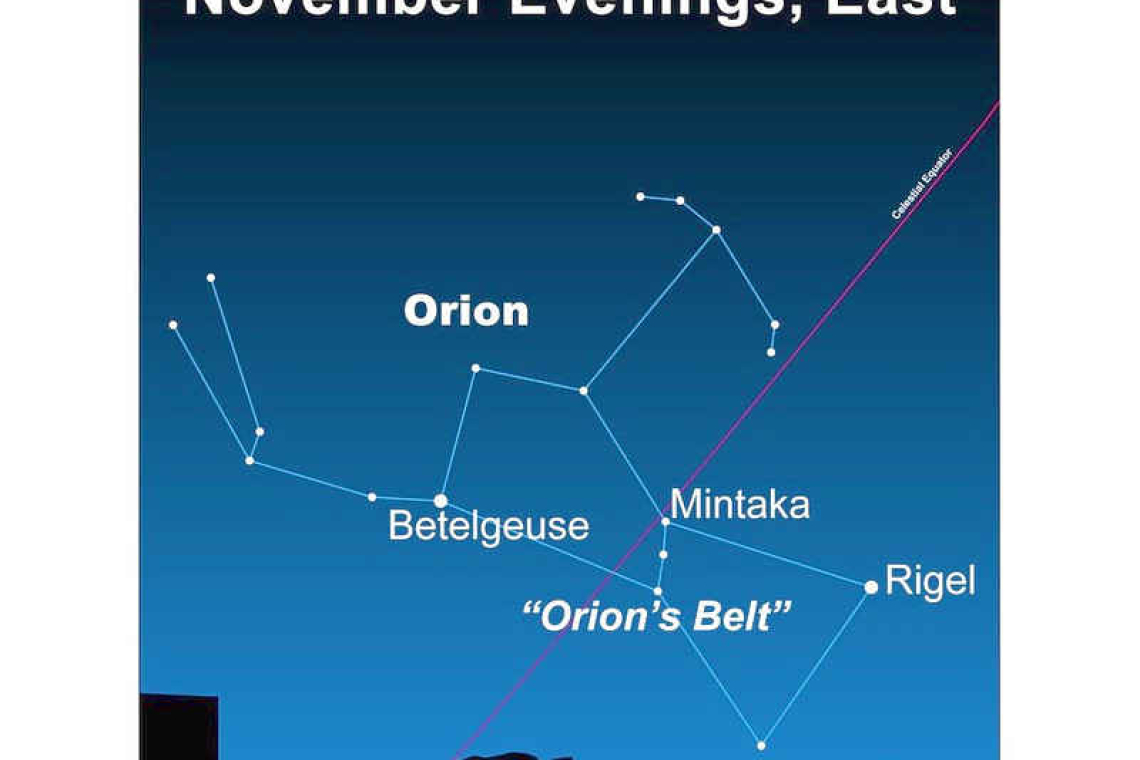~ St. Maarten’s Backyard Astronomy for November 17-19 ~
Sun rises at 6:19am
Sun sets at 5:34pm
Lunar phase:1st quarter, waxing crescent
Moon rises at 11:20am
Moon sets at 10:39pm
This weekend, let’s find the three stars that make up Orion’s belt. The familiar constellation, Orion the Hunter, dominates the night sky at this time of the year, those cold winter months. Of course, here in St. Maarten the winter is not so cold, but we still see the winter constellations shining brightly down on us, and Orion is the best place to start.
Orion rises about 8:00pm at the eastern horizon. He’s easy to find – just look for three bright stars in a short straight row.
The three stars that make up Orion’s belt are Alnitak, Alnilam and Mintaka. Other cultures see these stars in different ways, not as a belt. For instance, the Aymara people of Bolivia, Peru and Chile, see those three stars as a bridge. And that is actually rather interesting, because these stars could be said to link the sky’s northern and southern hemispheres. Mintaka, the Belt’s westernmost star, sits right on the sky’s celestial equator. That’s the projection of the Earth’s equator onto the night sky.
Mintaka’s location on the celestial equator makes it a good guidepost for finding directions here on Earth. That is, Mintaka and the other stars of Orion’s Belt, aka the Celestial Bridge, are visible worldwide. From all over the world, Mintaka rises due east, sets due west, and remains in the sky for 12 hours. It climbs to its highest point in the sky midway between rising and setting.
So, wherever you might be, find Orion’s Belt in the night sky, and wait until it’s at its highest point. If the stars of Orion’s belt are directly overhead, or as astronomers say, “at your zenith,” then you must be at the equator. But if they are in the southern half of your sky, then you must be north of the equator. Conversely, if the stars shine in the northern half of your sky, then you must be south of the equator. Sailors take heed of this handy locator trick, especially if your GPS goes down.
Meanwhile we can still see falling stars, shooting stars or meteors, this weekend. The Leonid meteor shower peaks this Saturday but can offer star-streak sights from November 3 to December 2. Your best bet is the early morning hours before dawn. The moon is a slim and dim crescent so you may see up to 20 meteors per hour. Interestingly, the Leonids occasionally are so plentiful they have been compared to a hail-storm. In 1966, on the night of November 17, many thousands of meteors per hour were seen. Most years, however, the Lion whimpers rather than roars.
Thank you for keeping up with the Night Sky articles, backyard astronomy designed for St. Maarten sky viewing. FYI: If you are out later on in the week, note that each star rises about four minutes earlier each day than written here, and the moon rises 50 minutes later. Night Sky is researched and compiled by Lisa Davis-Burnett. Earthsky.org is a key resource for information and images. Questions or comments? Email This email address is being protected from spambots. You need JavaScript enabled to view it.







